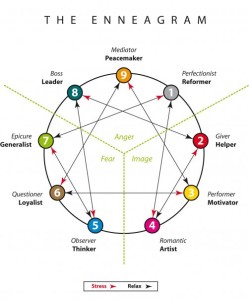The Enneagram (pronounced any-a-gram) is a powerful and dynamic personality system that offers profound insights of nine distinct and fundamentally different patterns of thinking, feeling, and behaving. Its power lies in the accuracy and depth of the personality descriptions and the transformational path it offers. It is also the most practical system for increasing emotional intelligence in work and personal life.
Origins
The origin of the Enneagram symbol is unclear, it might date back at least 2500 years around classical Greek philosophy period. But the modern Enneagram system including the psychology of the nine Enneagram types is the work of contemporary authors and is still evolving.
The three key contributors of the modern Enneagram system in the early days are: G.I. Gurdjieff in the 1930s, Oscar Ichazo in the 1960s and Claudio Naranjo in the 1970s who has brought Enneagram to the United States after studied the Enneagram with Ichazo.
Over time, the system has evolved and advanced by teachers such as Helen Palmer & David Daniels, Don Riso & Russ Hudson, Theodorre Donson & Kathy Hurley, Ginger Lapid-Bogda, Jerry Wagner, Sandra Maitri.
Applications
Currently, Enneagram has been used everywhere in the world because it is cross-cultural and highly accurate. It is a powerful tool for relationships, self-mastery, team building, leadership, conflict resolution, and for increasing emotional intelligence. The Enneagram has been widely used in many areas including psychotherapy, entertainment, business, health care, parenting, education, and spiritual growth.
Enneagram Symbol
The Enneagram symbol is a circle with nine points consists of a triangle and a hexagon enclosed within the circle. The symbol accounts for both aspects of human nature in its unity (the circle) and in the way it is divided (the triangle and hexagon).
In Greek, ennea means “nine” and gram means “drawing”. Hence, the Enneagram is a diagram with nine points representing the nine personality types, with each number representing one type.
While we have all the nine Enneagram types in us, we only have a core type and it remains the same throughout our life. However, the characteristics of our type may either soften or become more pronounced as we grow and develop.
Wings and Arrows
 There are four other types that may affect our patterns of thinking, feeling and behaving. The types next to our core type are called the wing, and one or both the wings may influence us.
There are four other types that may affect our patterns of thinking, feeling and behaving. The types next to our core type are called the wing, and one or both the wings may influence us.
The arrows in the Enneagram circle are the lines connected to our core type. The clockwise direction (3-6-9-3, 1-7-5-8-2-4-1) is called our “security point” or “heart point.” This may happen when we feel safe and secure, as in a close relationship, or when we are engaged in deep personal growth and our type structure relaxes. This is usually a positive experience, allowing us to integrate some qualities of our security point, which can balance our core type but we may also encounter new challenges at this point.
The anti-clockwise direction (3-9-6-3, 1-4-2-8-5-7-1) is called our “stress point,” which means that under certain kinds of stress, we may find ourselves experiencing more of the feelings and patterns of this other personality type, which can be a resource for us but it will be too stressful to stay there too long. For example, a Six move to Three may move more quickly into action; a Seven move to One may become more focused and organized.
Subtypes
The subtypes are very important for understanding personality and particularly useful when considering relationship issues. This is because a major aspect of human nature lies in our instinctual “hard wiring” as biological beings. It provides insight into the predominant preoccupation we have in our impulses and more gut-type reactions.
We each have a self-preservation instinct (for preserving the body and its life and functioning), a sexual instinct or one-to-one (for extending ourselves in the environment and through the generations, or intimate relationship), and a social instinct (for getting along with others and forming secure social bonds).
Each Enneagram type may express itself as a self-preservation, sexual (one-to-one) or social subtype. So, there are in total 27 personality types. We have all the three Instincts in us, but usually one subtype is more easily accessible and more frequently used than the others. The subtypes do not only offer insights but also impact on the flavour of our core type.
Peter O’Hanrahan is one of the world authority in Enneagram Subtypes.
